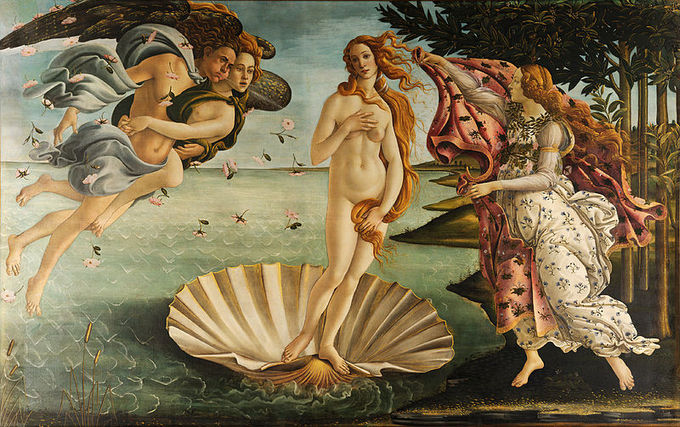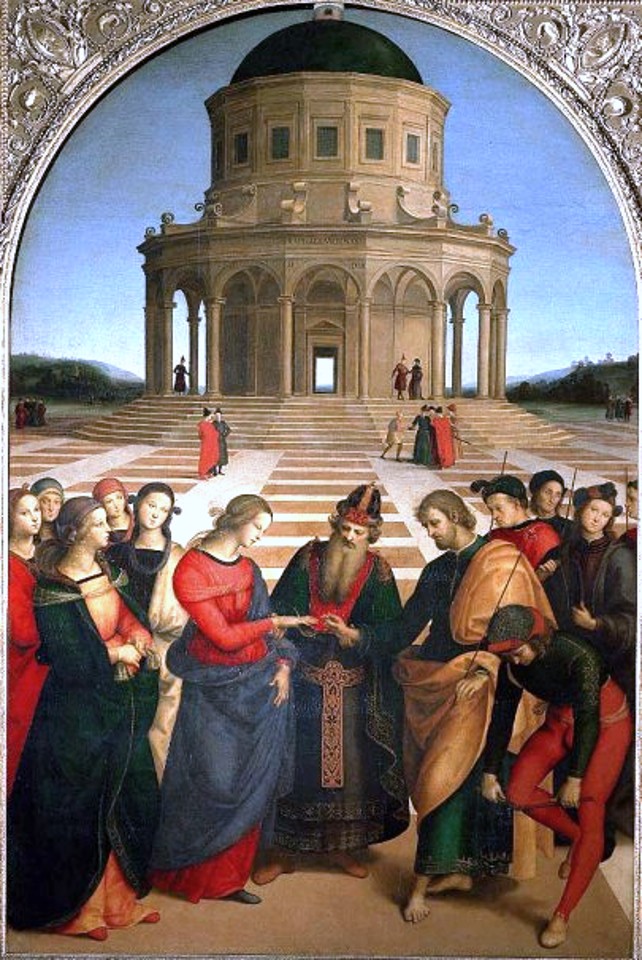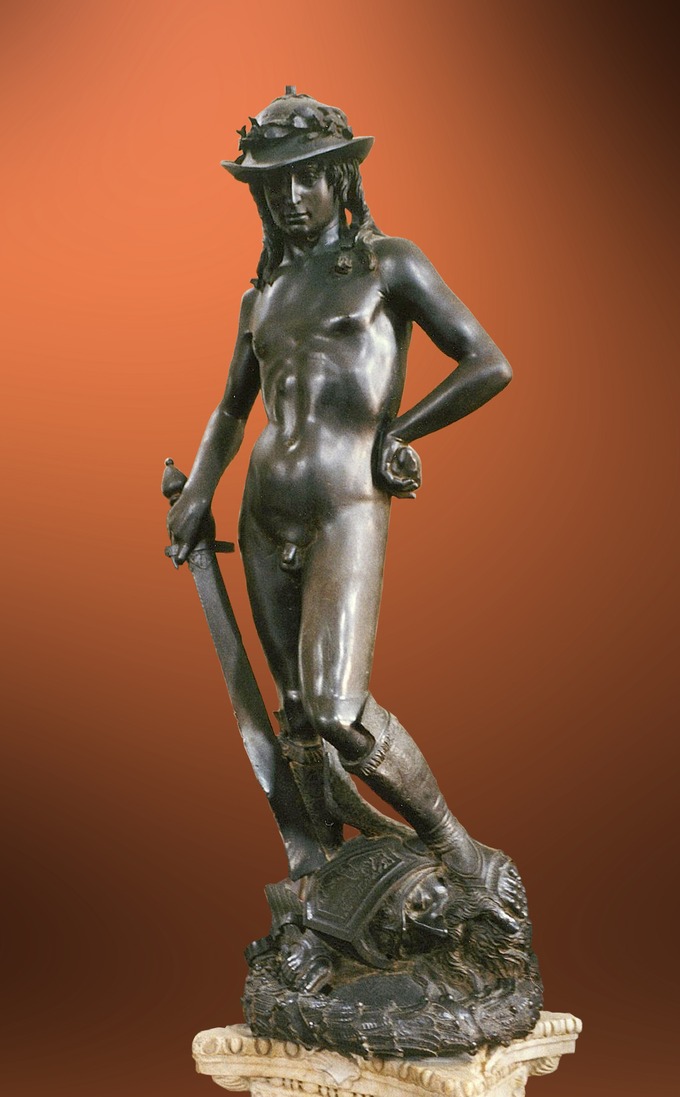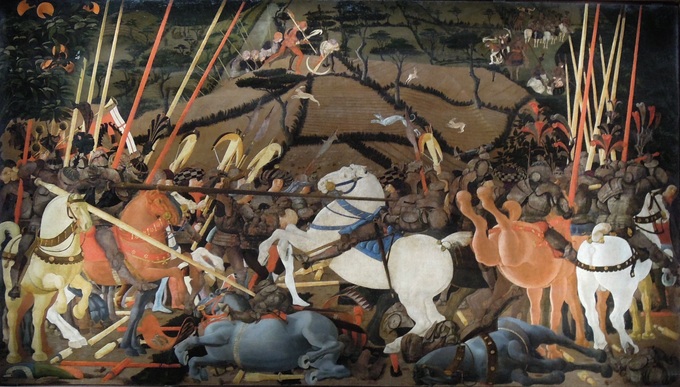19.1: The Italian Renaissance
- Page ID
- 53057
\( \newcommand{\vecs}[1]{\overset { \scriptstyle \rightharpoonup} {\mathbf{#1}} } \)
\( \newcommand{\vecd}[1]{\overset{-\!-\!\rightharpoonup}{\vphantom{a}\smash {#1}}} \)
\( \newcommand{\dsum}{\displaystyle\sum\limits} \)
\( \newcommand{\dint}{\displaystyle\int\limits} \)
\( \newcommand{\dlim}{\displaystyle\lim\limits} \)
\( \newcommand{\id}{\mathrm{id}}\) \( \newcommand{\Span}{\mathrm{span}}\)
( \newcommand{\kernel}{\mathrm{null}\,}\) \( \newcommand{\range}{\mathrm{range}\,}\)
\( \newcommand{\RealPart}{\mathrm{Re}}\) \( \newcommand{\ImaginaryPart}{\mathrm{Im}}\)
\( \newcommand{\Argument}{\mathrm{Arg}}\) \( \newcommand{\norm}[1]{\| #1 \|}\)
\( \newcommand{\inner}[2]{\langle #1, #2 \rangle}\)
\( \newcommand{\Span}{\mathrm{span}}\)
\( \newcommand{\id}{\mathrm{id}}\)
\( \newcommand{\Span}{\mathrm{span}}\)
\( \newcommand{\kernel}{\mathrm{null}\,}\)
\( \newcommand{\range}{\mathrm{range}\,}\)
\( \newcommand{\RealPart}{\mathrm{Re}}\)
\( \newcommand{\ImaginaryPart}{\mathrm{Im}}\)
\( \newcommand{\Argument}{\mathrm{Arg}}\)
\( \newcommand{\norm}[1]{\| #1 \|}\)
\( \newcommand{\inner}[2]{\langle #1, #2 \rangle}\)
\( \newcommand{\Span}{\mathrm{span}}\) \( \newcommand{\AA}{\unicode[.8,0]{x212B}}\)
\( \newcommand{\vectorA}[1]{\vec{#1}} % arrow\)
\( \newcommand{\vectorAt}[1]{\vec{\text{#1}}} % arrow\)
\( \newcommand{\vectorB}[1]{\overset { \scriptstyle \rightharpoonup} {\mathbf{#1}} } \)
\( \newcommand{\vectorC}[1]{\textbf{#1}} \)
\( \newcommand{\vectorD}[1]{\overrightarrow{#1}} \)
\( \newcommand{\vectorDt}[1]{\overrightarrow{\text{#1}}} \)
\( \newcommand{\vectE}[1]{\overset{-\!-\!\rightharpoonup}{\vphantom{a}\smash{\mathbf {#1}}}} \)
\( \newcommand{\vecs}[1]{\overset { \scriptstyle \rightharpoonup} {\mathbf{#1}} } \)
\( \newcommand{\vecd}[1]{\overset{-\!-\!\rightharpoonup}{\vphantom{a}\smash {#1}}} \)
\(\newcommand{\avec}{\mathbf a}\) \(\newcommand{\bvec}{\mathbf b}\) \(\newcommand{\cvec}{\mathbf c}\) \(\newcommand{\dvec}{\mathbf d}\) \(\newcommand{\dtil}{\widetilde{\mathbf d}}\) \(\newcommand{\evec}{\mathbf e}\) \(\newcommand{\fvec}{\mathbf f}\) \(\newcommand{\nvec}{\mathbf n}\) \(\newcommand{\pvec}{\mathbf p}\) \(\newcommand{\qvec}{\mathbf q}\) \(\newcommand{\svec}{\mathbf s}\) \(\newcommand{\tvec}{\mathbf t}\) \(\newcommand{\uvec}{\mathbf u}\) \(\newcommand{\vvec}{\mathbf v}\) \(\newcommand{\wvec}{\mathbf w}\) \(\newcommand{\xvec}{\mathbf x}\) \(\newcommand{\yvec}{\mathbf y}\) \(\newcommand{\zvec}{\mathbf z}\) \(\newcommand{\rvec}{\mathbf r}\) \(\newcommand{\mvec}{\mathbf m}\) \(\newcommand{\zerovec}{\mathbf 0}\) \(\newcommand{\onevec}{\mathbf 1}\) \(\newcommand{\real}{\mathbb R}\) \(\newcommand{\twovec}[2]{\left[\begin{array}{r}#1 \\ #2 \end{array}\right]}\) \(\newcommand{\ctwovec}[2]{\left[\begin{array}{c}#1 \\ #2 \end{array}\right]}\) \(\newcommand{\threevec}[3]{\left[\begin{array}{r}#1 \\ #2 \\ #3 \end{array}\right]}\) \(\newcommand{\cthreevec}[3]{\left[\begin{array}{c}#1 \\ #2 \\ #3 \end{array}\right]}\) \(\newcommand{\fourvec}[4]{\left[\begin{array}{r}#1 \\ #2 \\ #3 \\ #4 \end{array}\right]}\) \(\newcommand{\cfourvec}[4]{\left[\begin{array}{c}#1 \\ #2 \\ #3 \\ #4 \end{array}\right]}\) \(\newcommand{\fivevec}[5]{\left[\begin{array}{r}#1 \\ #2 \\ #3 \\ #4 \\ #5 \\ \end{array}\right]}\) \(\newcommand{\cfivevec}[5]{\left[\begin{array}{c}#1 \\ #2 \\ #3 \\ #4 \\ #5 \\ \end{array}\right]}\) \(\newcommand{\mattwo}[4]{\left[\begin{array}{rr}#1 \amp #2 \\ #3 \amp #4 \\ \end{array}\right]}\) \(\newcommand{\laspan}[1]{\text{Span}\{#1\}}\) \(\newcommand{\bcal}{\cal B}\) \(\newcommand{\ccal}{\cal C}\) \(\newcommand{\scal}{\cal S}\) \(\newcommand{\wcal}{\cal W}\) \(\newcommand{\ecal}{\cal E}\) \(\newcommand{\coords}[2]{\left\{#1\right\}_{#2}}\) \(\newcommand{\gray}[1]{\color{gray}{#1}}\) \(\newcommand{\lgray}[1]{\color{lightgray}{#1}}\) \(\newcommand{\rank}{\operatorname{rank}}\) \(\newcommand{\row}{\text{Row}}\) \(\newcommand{\col}{\text{Col}}\) \(\renewcommand{\row}{\text{Row}}\) \(\newcommand{\nul}{\text{Nul}}\) \(\newcommand{\var}{\text{Var}}\) \(\newcommand{\corr}{\text{corr}}\) \(\newcommand{\len}[1]{\left|#1\right|}\) \(\newcommand{\bbar}{\overline{\bvec}}\) \(\newcommand{\bhat}{\widehat{\bvec}}\) \(\newcommand{\bperp}{\bvec^\perp}\) \(\newcommand{\xhat}{\widehat{\xvec}}\) \(\newcommand{\vhat}{\widehat{\vvec}}\) \(\newcommand{\uhat}{\widehat{\uvec}}\) \(\newcommand{\what}{\widehat{\wvec}}\) \(\newcommand{\Sighat}{\widehat{\Sigma}}\) \(\newcommand{\lt}{<}\) \(\newcommand{\gt}{>}\) \(\newcommand{\amp}{&}\) \(\definecolor{fillinmathshade}{gray}{0.9}\)The Italian Renaissance
The art of the Italian Renaissance was influential throughout Europe for centuries.
Describe the art and periodization of the Italian Renaissance
Key Points
- The Florence school of painting became the dominant style during the Renaissance . Renaissance artworks depicted more secular subject matter than previous artistic movements.
- Michelangelo, da Vinci, and Rafael are among the best known painters of the High Renaissance .
- The High Renaissance was followed by the Mannerist movement, known for elongated figures.
Key Terms
- fresco: A type of wall painting in which color pigments are mixed with water and applied to wet plaster. As the plaster and pigments dry, they fuse together and the painting becomes a part of the wall itself.
- Mannerism: A style of art developed at the end of the High Renaissance, characterized by the deliberate distortion and exaggeration of perspective, especially the elongation of figures.
The Renaissance began during the 14th century and remained the dominate style in Italy, and in much of Europe, until the 16th century. The term “renaissance” was developed during the 19th century in order to describe this period of time and its accompanying artistic style. However, people who were living during the Renaissance did see themselves as different from their Medieval predecessors. Through a variety of texts that survive, we know that people living during the Renaissance saw themselves as different largely because they were deliberately trying to imitate the Ancients in art and architecture.
Florence and the Renaissance
When you hear the term “Renaissance” and picture a style of art, you are probably picturing the Renaissance style that was developed in Florence, which became the dominate style of art during the Renaissance. During the Middle Ages and the Renaissance, Italy was divided into a number of different city states. Each city state had its own government, culture , economy, and artistic style. There were many different styles of art and architecture that were developed in Italy during the Renaissance. Siena, which was a political ally of France, for example, retained a Gothic element to its art for much of the Renaissance.
Certain conditions aided the development of the Renaissance style in Florence during this time period. In the 15th century, Florence became a major mercantile center. The production of cloth drove their economy and a merchant class emerged. Humanism , which had developed during the 14th century, remained an important intellectual movement that impacted art production as well.
Early Renaissance
During the Early Renaissance, artists began to reject the Byzantine style of religious painting and strove to create realism in their depiction of the human form and space . This aim toward realism began with Cimabue and Giotto, and reached its peak in the art of the “Perfect” artists, such as Andrea Mantegna and Paolo Uccello, who created works that employed one point perspective and played with perspective for their educated, art knowledgeable viewer .
During the Early Renaissance we also see important developments in subject matter, in addition to style. While religion was an important element in the daily life of people living during the Renaissance, and remained a driving factor behind artistic production, we also see a new avenue open to panting—mythological subject matter. Many scholars point to Botticelli’s Birth of Venus as the very first panel painting of a mythological scene. While the tradition itself likely arose from cassone painting, which typically featured scenes from mythology and romantic texts, the development of mythological panel painting would open a world for artistic patronage , production, and themes.

High Renaissance
The period known as the High Renaissance represents the culmination of the goals of the Early Renaissance, namely the realistic representation of figures in space rendered with credible motion and in an appropriately decorous style. The most well known artists from this phase are Leonardo da Vinci, Raphael, Titian, and Michelangelo. Their paintings and frescoes are among the most widely known works of art in the world. Da Vinci’s Last Supper, Raphael’s The School of Athens and Michelangelo’s Sistine Chapel Ceiling paintings are the masterpieces of this period and embody the elements of the High Renaissance.

Mannerism
High Renaissance painting evolved into Mannerism in Florence. Mannerist artists, who consciously rebelled against the principles of High Renaissance, tended to represent elongated figures in illogical spaces. Modern scholarship has recognized the capacity of Mannerist art to convey strong, often religious, emotion where the High Renaissance failed to do so. Some of the main artists of this period are Pontormo, Bronzino, Rosso Fiorentino, Parmigianino and Raphael’s pupil, Giulio Romano.
Humanism
Humanism was an intellectual movement embraced by scholars, writers, and civic leaders in 14th century Italy.
Assess how Humanism gave rise to the art of the Renasissance
Key Points
- Humanists reacted against the utilitarian approach to education, seeking to create a citizenry who were able to speak and write with eloquence and thus able to engage the civic life of their communities.
- The movement was largely founded on the ideals of Italian scholar and poet Francesco Petrarca, which were often centered around humanity’s potential for achievement.
- While Humanism initially began as a predominantly literary movement, its influence quickly pervaded the general culture of the time, reintroducing classical Greek and Roman art forms and leading to the Renaissance .
- Donatello became renowned as the greatest sculptor of the Early Renaissance, known especially for his Humanist, and unusually erotic, statue of David.
- While medieval society viewed artists as servants and craftspeople, Renaissance artists were trained intellectuals, and their art reflected this newfound point of view.
- In humanist painting, the treatment of the elements of perspective and depiction of light became of particular concern.
Key Terms
- High Renaissance: The period in art history denoting the apogee of the visual arts in the Italian Renaissance. The High Renaissance period is traditionally thought to have begun in the 1490s—with Leonardo’s fresco of The Last Supper in Milan and the death of Lorenzo de’ Medici in Florence—and to have ended in 1527, with the Sack of Rome by the troops of Charles V.
Overview
Humanism, also known as Renaissance Humanism, was an intellectual movement embraced by scholars, writers, and civic leaders in 14th- and early-15th-century Italy. The movement developed in response to the medieval scholastic conventions in education at the time, which emphasized practical, pre-professional, and scientific studies engaged in solely for job preparation, and typically by men alone. Humanists reacted against this utilitarian approach, seeking to create a citizenry who were able to speak and write with eloquence and thus able to engage the civic life of their communities. This was to be accomplished through the study of the “studia humanitatis,” known today as the humanities: grammar, rhetoric, history, poetry, and moral philosophy. Humanism introduced a program to revive the cultural—and particularly the literary—legacy and moral philosophy of classical antiquity . The movement was largely founded on the ideals of Italian scholar and poet Francesco Petrarca, which were often centered around humanity’s potential for achievement.
While Humanism initially began as a predominantly literary movement, its influence quickly pervaded the general culture of the time, re-introducing classical Greek and Roman art forms and contributing to the development of the Renaissance. Humanists considered the ancient world to be the pinnacle of human achievement, and thought its accomplishments should serve as the model for contemporary Europe. There were important centers of Humanism in Florence, Naples, Rome , Venice , Genoa, Mantua, Ferrara, and Urbino .
Humanism was an optimistic philosophy that saw man as a rational and sentient being, with the ability to decide and think for himself. It saw man as inherently good by nature, which was in tension with the Christian view of man as the original sinner needing redemption. It provoked fresh insight into the nature of reality, questioning beyond God and spirituality, and provided knowledge about history beyond Christian history.
Humanist Art
Renaissance Humanists saw no conflict between their study of the Ancients and Christianity. The lack of perceived conflict allowed Early Renaissance artists to combine classical forms, classical themes, and Christian theology freely. Early Renaissance sculpture is a great vehicle to explore the emerging Renaissance style . The leading artists of this medium were Donatello, Filippo Brunelleschi, and Lorenzo Ghiberti. Donatello became renowned as the greatest sculptor of the Early Renaissance, known especially for his classical, and unusually erotic, statue of David, which became one of the icons of the Florentine republic.

Humanism affected the artistic community and how artists were perceived. While medieval society viewed artists as servants and craftspeople, Renaissance artists were trained intellectuals, and their art reflected this newfound point of view. Patronage of the arts became an important activity, and commissions included secular subject matter as well as religious. Important patrons , such as Cosimo de’ Medici, emerged and contributed largely to the expanding artistic production of the time.
In painting, the treatment of the elements of perspective and light became of particular concern. Paolo Uccello, for example, who is best known for “The Battle of San Romano,” was obsessed by his interest in perspective, and would stay up all night in his study trying to grasp the exact vanishing point . He used perspective in order to create a feeling of depth in his paintings. In addition, the use of oil paint had its beginnings in the early part of the 16th century, and its use continued to be explored extensively throughout the High Renaissance .

Origins
Some of the first Humanists were great collectors of antique manuscripts, including Petrarch, Giovanni Boccaccio, Coluccio Salutati, and Poggio Bracciolini. Of the three, Petrarch was dubbed the “Father of Humanism” because of his devotion to Greek and Roman scrolls. Many worked for the organized church and were in holy orders (like Petrarch), while others were lawyers and chancellors of Italian cities (such as Petrarch’s disciple Salutati, the Chancellor of Florence) and thus had access to book-copying workshops.
In Italy, the Humanist educational program won rapid acceptance and, by the mid-15th century, many of the upper classes had received Humanist educations, possibly in addition to traditional scholastic ones. Some of the highest officials of the church were Humanists with the resources to amass important libraries. Such was Cardinal Basilios Bessarion, a convert to the Latin church from Greek Orthodoxy, who was considered for the papacy and was one of the most learned scholars of his time.
Following the Crusader sacking of Constantinople and the end of the Byzantine Empire in 1453, the migration of Byzantine Greek scholars and émigrés, who had greater familiarity with ancient languages and works, furthered the revival of Greek and Roman literature and science.
- Curation and Revision. Provided by: Boundless.com. License: CC BY-SA: Attribution-ShareAlike
- Italian Renaissance painting. Provided by: Wikipedia. Located at: en.Wikipedia.org/wiki/Italian_Renaissance_painting. License: Public Domain: No Known Copyright
- Sandro Botticelli - La nascita di Venere - Google Art Project - edited. Provided by: Wikipedia. Located at: en.Wikipedia.org/wiki/File:Sandro_Botticelli_-_La_nascita_di_Venere_-_Google_Art_Project_-_edited.jpg. License: Public Domain: No Known Copyright
- The Marriage of the Virgin (Raphael). Provided by: Wikipedia. Located at: en.Wikipedia.org/wiki/The_Marriage_of_the_Virgin_(Raphael). License: CC BY-SA: Attribution-ShareAlike
- Mannerism. Provided by: Wiktionary. Located at: en.wiktionary.org/wiki/Mannerism. License: CC BY-SA: Attribution-ShareAlike
- The Birth of Venus (Botticelli). Provided by: Wikipedia. Located at: en.Wikipedia.org/wiki/The_Birth_of_Venus_(Botticelli). License: CC BY-SA: Attribution-ShareAlike
- Italian Renaissance. Provided by: Wikipedia. Located at: en.Wikipedia.org/wiki/Italian_Renaissance. License: CC BY-SA: Attribution-ShareAlike
- fresco. Provided by: Wiktionary. Located at: en.wiktionary.org/wiki/fresco. License: CC BY-SA: Attribution-ShareAlike
- sfumato. Provided by: Wiktionary. Located at: en.wiktionary.org/wiki/sfumato. License: CC BY-SA: Attribution-ShareAlike
- Uccello Battle of San Romano Uffizi. Provided by: Wikipedia. Located at: en.Wikipedia.org/wiki/File:Uccello_Battle_of_San_Romano_Uffizi.jpg. License: CC BY-SA: Attribution-ShareAlike
- Donatello - David - Florenu00e7a. Provided by: Wikimedia. Located at: commons.wikimedia.org/wiki/File:Donatello_-_David_-_Floren%C3%A7a.jpg. License: CC BY-SA: Attribution-ShareAlike
- Paolo Uccello. Provided by: Wikipedia. Located at: en.Wikipedia.org/wiki/Paolo_Uccello. License: CC BY-SA: Attribution-ShareAlike
- David (Donatello). Provided by: Wikipedia. Located at: en.Wikipedia.org/wiki/David_(Donatello). License: CC BY-SA: Attribution-ShareAlike
- The Battle of San Romano. Provided by: Wikipedia. Located at: en.Wikipedia.org/wiki/The_Battle_of_San_Romano. License: CC BY-SA: Attribution-ShareAlike
- Humanism. Provided by: Wikipedia. Located at: en.Wikipedia.org/wiki/Humanism. License: CC BY-SA: Attribution-ShareAlike
- High Renaissance. Provided by: Wikipedia. Located at: en.Wikipedia.org/wiki/High%20Renaissance. License: CC BY-SA: Attribution-ShareAlike


